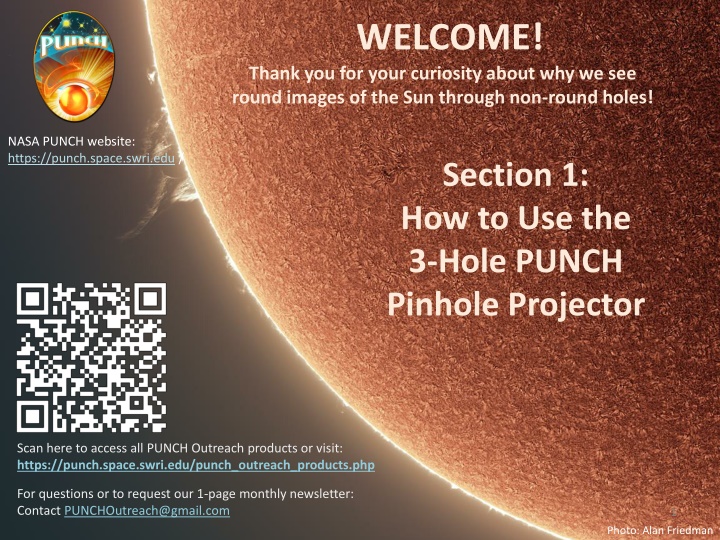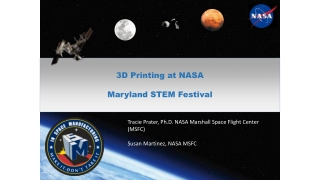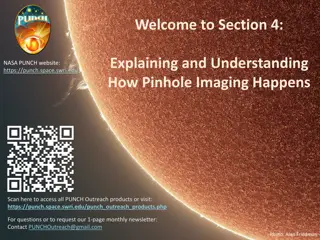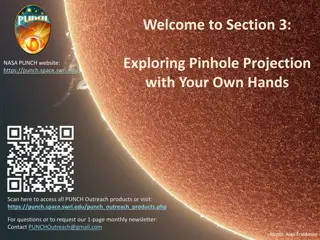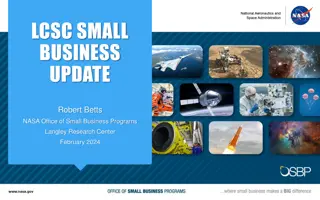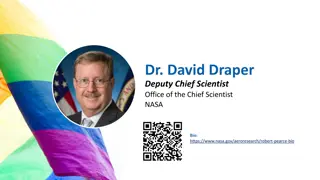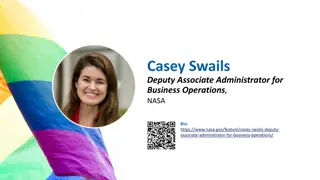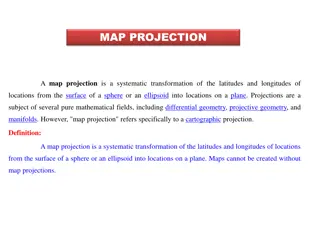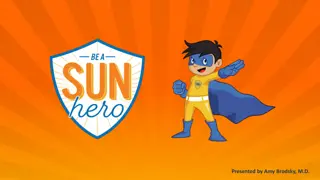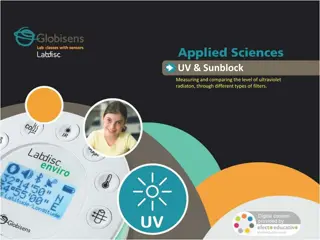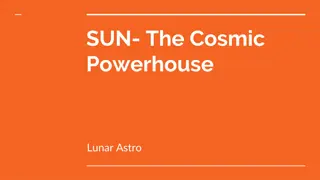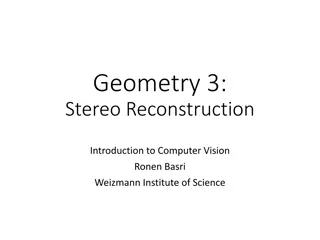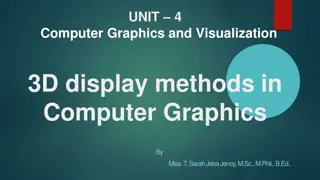Pinhole Projection of the Sun with NASA PUNCH Outreach
Delve into the fascinating world of pinhole projection with NASA's PUNCH Outreach program. Explore how round images of the Sun are seen through non-round holes, learn how to use the 3-Hole PUNCH Pinhole Projector, and gain insights into pinhole imaging both indoors and outdoors. Discover the playful learning adventure offered by Bhanu as you deepen your understanding of this phenomenon. Engage with interactive materials, instructional videos, and helpful resources to enhance your knowledge. Join the mission and unravel the mysteries of pinhole projection with NASA PUNCH Outreach.
Download Presentation

Please find below an Image/Link to download the presentation.
The content on the website is provided AS IS for your information and personal use only. It may not be sold, licensed, or shared on other websites without obtaining consent from the author.If you encounter any issues during the download, it is possible that the publisher has removed the file from their server.
You are allowed to download the files provided on this website for personal or commercial use, subject to the condition that they are used lawfully. All files are the property of their respective owners.
The content on the website is provided AS IS for your information and personal use only. It may not be sold, licensed, or shared on other websites without obtaining consent from the author.
E N D
Presentation Transcript
WELCOME! Thank you for your curiosity about why we see round images of the Sun through non-round holes! NASA PUNCH website: https://punch.space.swri.edu / Section 1: How to Use the 3-Hole PUNCH Pinhole Projector Scan here to access all PUNCH Outreach products or visit: https://punch.space.swri.edu/punch_outreach_products.php For questions or to request our 1-page monthly newsletter: Contact PUNCHOutreach@gmail.com 1 Photo: Alan Friedman
[Really] Understanding Pinhole Projection of the Sun Follow along with our playful learning adventure! Outreach for the NASA PUNCH mission And PLEASE give us feedback on these questions at the link below: Insights gained? Remaining questions? Ideas for improvements? https://tinyurl.com/PinholeFeedback MARK 3 Version Final Release for use up to and including the Annular Eclipse on 14 Oct 2023 FRONT BACK 2
Essential viewing: 6-minute how-to-facilitate video [ https://punch.space.swri.edu/punch_outreach_pinholeprojector.php ] Outreach for the NASA PUNCH mission 3
[Really] Understanding Pinhole Projection of the Sun Introducing Bhanu [BAH-noo] Bhanu means ray of light in Sanskrit Outreach for the NASA PUNCH mission Bhanu helps guide our way through these Sections. You are in Section 1 of 5. Section Title of Section Description of Section introduces the 3-Hole PUNCH Pinhole Projector, demonstrates how to use it both outdoors and indoors, and describes its differences from a pinhole camera/viewer. How to Use the 3-Hole PUNCH Pinhole Projector 1 Observing Pinhole Images of the Sun in Our Everyday Environments teaches you how to observe the phenomenon of pinhole images of the Sun in our everyday world, both indoors and outdoors. 2 Exploring Pinhole Projection Using Your Own Hands invites you to explore the behavior of pinhole projection by experimenting with your own hands (try both palms up!) 3 interactively guides your quest for explanations and deeper understanding of how pinhole imaging happens. After this, you will really understand why small, lens-less holes can create images. Explaining and Understanding How Pinhole Imaging Happens 4 APPENDICES A-E: More Insights & Fun Resources offers more insights & resources (e.g., explaining the relationship between pinhole images and the view through eclipse glasses) 5 CONTACT: Dr. Cherilynn Morrow, Outreach Director for the NASA PUNCH mission [cherilynn.morrow@gmail.com] 4
1. How to Use the 3-Hole PUNCH Pinhole Projector Outreach for the NASA PUNCH mission Bahnu says: Pinhole describes a projector or camera that does not use a hard lens but only a small hole or gap to make images of the Sun or other objects. A pinhole does not have to be pin-sized to create an image of the Sun, nor does it have to be round! Section 5: Appendix C explains the difference between a lens-less pinhole and a lens and helps you to appreciate more what a lens is doing to make a clear image. 5 CONTACT: Dr. Cherilynn Morrow, Outreach Director for the NASA PUNCH mission [cherilynn.morrow@gmail.com]
Introducing the 3-Hole PUNCH Pinhole Projector 6 inches (~15 cm) BACK FRONT The NASA PUNCH Outreach team has developed the 3-Hole PUNCH Pinhole Projector so you can have fun exploring how small, non-round holes can project real images of the round Sun. This can be done on any sunny day, not only when the Sun is eclipsed by the Moon! 6
Introducing the 3-Hole PUNCH Pinhole Projector Our projector is printed on card stock with three small (~5 mm) holes of different shapes: square, round, and triangular. 6 inches (~15 cm) BACK FRONT Our design has carefully considered the size, position, and spacing of the pinholes so that the projector can work well indoors or outdoors in broad daylight. Section 5: Appendix D explains our design trade-offs. 7
Using the PUNCH Pinhole Projector NEVER EVER look at the Sun through the holes in the card! 1 Sunlight comes from this direction Outreach for the NASA PUNCH mission 2 Passes through the 3 different shaped holes Smooth flat projection surface 3 JO is 3 round images of the Sun appear in the shadow of projector observing in the morning in December JO is using a vertical wall as the smooth flat projection surface because the Sun is lower in the sky. If the Sun were higher, then a horizontal surface like a sidewalk might work better. 8
1. Projector close to surface. Triangle, round, and square shapes of light are sharp. 2. Projector farther away from surface. All three shapes of light are round and fuzzier. Smooth flat projection surface Case 2 Case 1 Outreach for the NASA PUNCH mission Were you able to observe bothCase 1 and Case 2? Image of round Sun through square hole Sunlight comes from this direction and passes thru the holes square shape of light KEY QUESTION: Why don t we see round images of the Sun when the projector is held closer to the projection surface (Case 1), but we do see them when we move it farther away (Case 2)? JO is observing in the morning in Dec 9
Indoor Use of the PUNCH Pinhole Projector You can try out using the projector where sunlight streams through a window. You will get the same effects as outdoors, but there is less stray light indoors compared to broad daylight. Thus, as you move the projector farther away from the projection surface you can more easily perceive larger, dimmer, and somewhat sharper images. The projected image size can become much larger than the hole size. Play with your Projector in different situations to see what can happen! 10
Using an Indoor Light Fixture as a Light Source Instead of the Sun Being observant and playful leads to cool discoveries! In Dec 2022, PUNCH team members and collaborators contributing engagement program at the Adler Planetarium in Chicago discovered that our projector could project images of the ceiling lights! As you can see below, at the Adler, the spotlights in the ceiling are star-shaped!* to a public RK demonstrates our pinhole projector indoors for Adler visitors. The projections are star-shaped because the light source is star-shaped. 11
Pinhole Projection Using a Masked LED Lamp as the Light Source Instead of the Sun Lamp OFF Projection surface The mask changes the shape of the light source. Try using our projector with a (low-temperature) LED light fixture. Lamp ON Use a cut out to alter the shape of the light source. NOTE: If the Projector were held closer to the surface, we would still see the triangular, round, and square-shaped holes. The Projector holes are each imaging the star shape of the light source. NOTE: See Section 5, Appendix A for a neat demo using the F-shaped mask. 12
What is the difference between our Pinhole Projector and a Pinhole Camera? Set-up for a Pinhole Projector Set-up for a Pinhole Viewer or Camera Image of round Sun Image of round Sun through square hole through square hole Projection Projection surface in surface in broad daylight broad daylight Darkened Darkened Projection Projection surface surface Pinhole Pinhole camera camera Light rays Light rays P P Sunlight comes from this direction and passes thru the 3 holes Pin Pin- -sized sized pinhole pinhole Adapted from Figure 3 https://www.scratchapixel.com/lessons/3d-basic-rendering/3d-viewing-pinhole-camera Important differences are the size of the hole and whether the projection surface must be in the dark rather than working in broad daylight. See Table on the next slide. Section 5: Appendix D provides details about our design trade-offs and why our pinhole projector has larger holes than pinhole cameras which have pin-sized holes. 3-Hole PUNCH Pinhole Projector with ~ 5mm holes 13
What is the difference between our Pinhole Projector and a Pinhole Camera? Compare the images on the previous slide to help interpret the Table Outreach for the NASA PUNCH mission Pinhole Camera Pinhole Projector Size of Hole Pin-sized hole Larger holes (~5 mm) Can be the Sun or other bright light source, even indoor lighting fixtures Object being imaged Can be the Sun but is usually an object reflecting the Sun s light To see the dim image formed through a tiny hole, you must enclose the projection surface in a space that is completely dark. Images can be seen in broad daylight. They appear on a projection surface in the shade of projector. Projected images Photos can be created using light-sensitive paper or film on the projection surface Photography Does not record photos Bahnu says: Prove that a pin-sized hole won t create an image of the Sun that you can see in broad daylight. Use a pin or thumb tack to poke a hole in our projector so you can compare what happens with a pinhole-sized hole vs the 5mm holes of the Projector. Remember that Section 5: Appendix D explains our design trade-offs. 14
Pinhole Projection of the Sun Observing the 2017 solar eclipse using a simple pinhole projector with a single square hole. Outreach for the NASA PUNCH mission RB is observing on 21 August 2017 in Roberts, Idaho at 10:52 am Pinhole image of the round Sun being eclipsed by the Moon during the 2017 Great American Eclipse Rays of sunlight square holein a 3 x 5 card can be a pinhole projector 15
During solar eclipses it is easier to tell that we are seeing real pinhole images of the eclipsed Sun among the shadows of leaves. Gaps between tree leaves make wonderful pinhole image displays as the Moon eclipses the Sun. Upper left image by Cantavestrella. See Credits & Acknowledgements. 16
ADDITIONAL INFORMATION Outreach for the NASA PUNCH mission Link for Feedback Valuable References Credits & Acknowledgements Links to PUNCH & PUNCH Outreach Products 17 CONTACT: Dr. Cherilynn Morrow, Outreach Director for the NASA PUNCH mission [cherilynn.morrow@gmail.com]
PLEASE GIVE US YOUR FEEDBACK We take all feedback very seriously and are using it to keep improving our projector and this presentation. Outreach for the NASA PUNCH mission Please scan the QR code or go to this URL to give us feedback https://tinyurl.com/PinholeFeedback Insights gained? Remaining questions? Ideas for improvements? MARK 3 Version Final Release for use up to and including the Annular Eclipse on 14 Oct 2023 BACK FRONT 18
Valuable References 1. Lenses and Pinholes: What Does In Focus Mean? A brief and clear explanation about what it means to be in focus : https://www.physicsforums.com/insights/lenses-pinholes-focus-mean/ 2. How a Pinhole Camera Works (Part 1) Excellent diagrams: https://www.scratchapixel.com/lessons/3d-basic-rendering/3d-viewing-pinhole-camera 3. Real image: Collection of focus points made by converging light rays We love the simple but insightful stick-figure: https://www.wikiwand.com/en/Real_image 4. Your Eyes See Upside Down and Reversed Lucid explanation by an eye doctor (MD) relating human eye to a pinhole camera: https://bceye.com/retinal-image-inverted-reversed/ 5. Camera Obscura The history of this wondrous effect, including reference to a possible paleo-camera: https://en.wikipedia.org/wiki/Camera_obscura http://paleo-camera.com/archeo-optics/ 6. Making, Measuring and Testing the Optimal Pinhole A thorough and playful journey through the technical details of pinhole photography: https://www.35mmc.com/26/10/2020/making-measuring-and-testing-the-optimal-pinhole-pinhole- adventures-part-3-by-sroyon/ 19
Credits & Acknowledgements Primary Authors of the Explanatory Presentations: Cherilynn Morrow, Robert Bigelow, and Mike Zawaski cherilynn.morrow@gmail.com , arca965@gmail.com, and mjzawaski@gmail.com Research & Development Team for the 3-Hole PUNCH Pinhole Projector Cherilynn Morrow (editor-in-chief, concept development, field testing, photos) Robert Bigelow (concept development, technical specifications, text reviewer, photos) Briana Ingermann (graphic design, text developer, field testing, procurement of printing, photos) Mike Zawaski (reviewer/consultant on explanatory presentation, graphic support, photos) Sanlyn Buxner (head of field testing and evaluation, photos) Jason Trump, Nina Byers, Geoff Skelton (text reviewer, field testing, reviewer of explanatory presentations) Marisa Bevington & Marialis Rosario Franco (text reviewers, Spanish language translation) GB Cornucopia, Bobbye Middendorf, Jeremy Osowski, Stacy Wolff (text reviewers, field testers, photo collaborators) Craig DeForest (PUNCH PI, product review and approval, field tester) Sarah Gibson (PUNCH Project Scientist, product review and approval) Nicki Viall (PUNCH Mission Scientist, field tester, product review and approval) Ronnie Killough (PUNCH Program Manager, field tester) Gilly Gilbert (PUNCH Associate Investigator, field tester) Countless others (who participated in field testing events and gave us their feedback) 20 Thank you also to our web developer Don Kolinski for posting and updating our work on the PUNCH website.
Please proceed to Section 2: Observing Pinhole Images of the Sun in Our Everyday Environments NASA PUNCH website: https://punch.space.swri.edu / Scan here to access all PUNCH Outreach products or visit: https://punch.space.swri.edu/punch_outreach_products.php For questions or to request our 1-page monthly newsletter: Contact PUNCHOutreach@gmail.com 21 Photo: Alan Friedman
